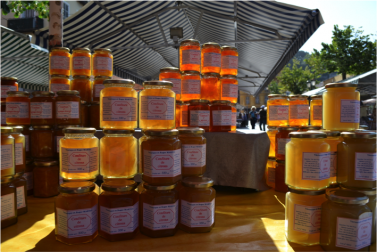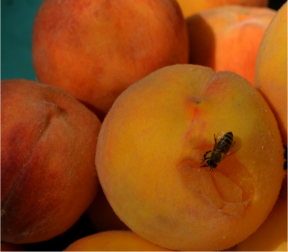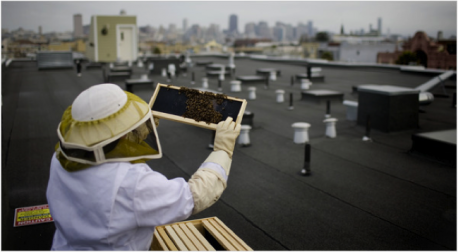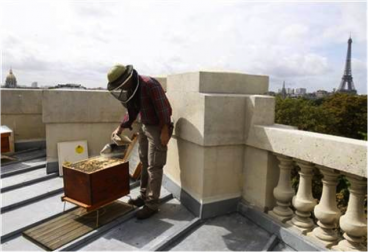Buzzing Rooftops: The Ins and Outs of Urban Beekeeping

Who will you meet?
Cities are innovating, companies are pivoting, and start-ups are growing. Like you, every urban practitioner has a remarkable story of insight and challenge from the past year.
Meet these peers and discuss the future of cities in the new Meeting of the Minds Executive Cohort Program. Replace boring virtual summits with facilitated, online, small-group discussions where you can make real connections with extraordinary, like-minded people.
In the springtime in Provence, France, the countryside explodes with plush, fluffy looking purple fields. It’s lavender season. Even more miraculous than the aroma of sweet lavender is the sound coming from the fields – they actually buzz with honeybees. When the first taste of lavender honey hit my lips was about the time that my fascination with honeybees and beekeeping began.
Bees on the Rise
 Urban Beekeeping has been on the rise over the past decade. Some reasons for this trend include: the coining of Colony Collapse Disorder (CCD) in 2006 and subsequent efforts to combat it, Michelle Obama placing beehives on the White House lawn in 2009, the legalization of urban beekeeping in New York City in 2010, and the growth of the Local Food Movement.
Urban Beekeeping has been on the rise over the past decade. Some reasons for this trend include: the coining of Colony Collapse Disorder (CCD) in 2006 and subsequent efforts to combat it, Michelle Obama placing beehives on the White House lawn in 2009, the legalization of urban beekeeping in New York City in 2010, and the growth of the Local Food Movement.
In cities around the globe, urban beekeeping is gaining popularity as a local method of honey production. The Greater London Area has seen a three-fold increase in the number of beekeepers since 2008, with the UK’s National Bee Unit Database tallying 1,237 beekeepers and over 3,500 hives in 2013. A New York Times article highlights the San Francisco Beekeeper’s Association increasing from about 50 SF beekeepers in 2000 to over 400 in 2010. With this rapid increase in urban beehives, scientists are questioning whether or not urban beekeeping is actually a good thing.
The “Sweet Spot” of Urban Beekeeping
 A recent study published in The Biologist argues that urban beekeeping has gone too far. Scientists Alton and Ratnieks have found that in London, there are now 25 beehives per square mile of city. Without enough flowers to support a population this size, city bees end up famished. The scientists advise that those looking to help the honeybee population should plant bee friendly flowers instead of managing a hive. In the United States, most cities have enough flowers to support the growing numbers of urban apiarists. However, an uptick in urban beekeeping does mean increasing the population density of one species. This inevitably tips the natural balance of the ecosystem and other factors, such as food supply for bees, need to be considered.
A recent study published in The Biologist argues that urban beekeeping has gone too far. Scientists Alton and Ratnieks have found that in London, there are now 25 beehives per square mile of city. Without enough flowers to support a population this size, city bees end up famished. The scientists advise that those looking to help the honeybee population should plant bee friendly flowers instead of managing a hive. In the United States, most cities have enough flowers to support the growing numbers of urban apiarists. However, an uptick in urban beekeeping does mean increasing the population density of one species. This inevitably tips the natural balance of the ecosystem and other factors, such as food supply for bees, need to be considered.
On the other hand, urban beekeeping practices in Paris are supporting healthier hives compared to collapsing colonies in rural areas. Urban areas are generally pesticide-free and have a greater variety of flowers compared to monoculture farms that dominate rural landscapes. Additionally, gardens in urban areas are designed to flower all year round, providing a constant food source for bees.

Photo Credit: Lianne Milton for The New York
In an NBC News article, Henri Clement, the president of the National Union of French Beekeepers, states that urban bees in Paris are producing as much as 5 times the amount of honey as rural bees. The death rate of urban colonies is 3 to 5 percent in Paris, whereas in the country, the death rate of colonies is 30 to 40 percent. With no pesticides in the pollen and greater biodiversity of flowers, cities are counter-intuitively better able to support honeybees than rural landscapes.
Back in San Francisco, I had the opportunity to shadow an urban beekeeper in the sunny hills of Noe Valley. Our faces covered by nets and smoker in hand, we set out to do hive maintenance. The five hives were positioned in this beekeeper’s back garden with clear flight paths, so the bees don’t end up flying into neighbors’ windows (a requirement in city settings). Honeybees generally tend to fly within a two-mile radius for food. With no shortage of flowers in sight, his hives were dripping with honey. As a member of the SF Beekeeping Association, he will often get calls about hives that have been “rescued” from buildings and are looking for a home, a more sustainable alternative to calling the exterminator.

Photo Credit: Francis Mori / AP
Urban beekeeping is a way to reconnect with the natural world that we urbanites have become so separate from. The above-mentioned study from the Biologist, warning against urban beekeeping, has received much press. However, since the study is geographically specific, it should not deter urban dwellers from taking up beekeeping, as long as they consider the larger ecosystem. Urban beekeeping is a way to make urban habitats more habitable. It is a way for city dwellers to actively create the environment they want to live in. An environment that supports beekeeping means more green space, more perennial flowering plants, and the buzzing sound of a healthy bee population, just like the lavender fields of Provence.
Discussion
Leave your comment below, or reply to others.
Please note that this comment section is for thoughtful, on-topic discussions. Admin approval is required for all comments. Your comment may be edited if it contains grammatical errors. Low effort, self-promotional, or impolite comments will be deleted.
Read more from MeetingoftheMinds.org
Spotlighting innovations in urban sustainability and connected technology
Middle-Mile Networks: The Middleman of Internet Connectivity
The development of public, open-access middle mile infrastructure can expand internet networks closer to unserved and underserved communities while offering equal opportunity for ISPs to link cost effectively to last mile infrastructure. This strategy would connect more Americans to high-speed internet while also driving down prices by increasing competition among local ISPs.
In addition to potentially helping narrow the digital divide, middle mile infrastructure would also provide backup options for networks if one connection pathway fails, and it would help support regional economic development by connecting businesses.
Wildfire Risk Reduction: Connecting the Dots
One of the most visceral manifestations of the combined problems of urbanization and climate change are the enormous wildfires that engulf areas of the American West. Fire behavior itself is now changing. Over 120 years of well-intentioned fire suppression have created huge reserves of fuel which, when combined with warmer temperatures and drought-dried landscapes, create unstoppable fires that spread with extreme speed, jump fire-breaks, level entire towns, take lives and destroy hundreds of thousands of acres, even in landscapes that are conditioned to employ fire as part of their reproductive cycle.
ARISE-US recently held a very successful symposium, “Wildfire Risk Reduction – Connecting the Dots” for wildfire stakeholders – insurers, US Forest Service, engineers, fire awareness NGOs and others – to discuss the issues and their possible solutions. This article sets out some of the major points to emerge.
Innovating Our Way Out of Crisis
Whether deep freezes in Texas, wildfires in California, hurricanes along the Gulf Coast, or any other calamity, our innovations today will build the reliable, resilient, equitable, and prosperous grid tomorrow. Innovation, in short, combines the dream of what’s possible with the pragmatism of what’s practical. That’s the big-idea, hard-reality approach that helped transform Texas into the world’s energy powerhouse — from oil and gas to zero-emissions wind, sun, and, soon, geothermal.
It’s time to make the production and consumption of energy faster, smarter, cleaner, more resilient, and more efficient. Business leaders, political leaders, the energy sector, and savvy citizens have the power to put investment and practices in place that support a robust energy innovation ecosystem. So, saddle up.






0 Comments